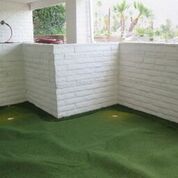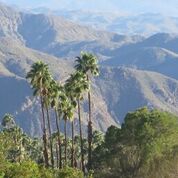Water conservation and water-saving garden solutions have a creative edge in the Coachella Valley of south California, and in Palm Springs sheets of glass reflecting sheets of water give a refreshing fresh sparkle to arid gardens.

Three months and two trips to California, from one destination south, to one north (which you can read about next month), have taught me a lot about what it means to live in a climate where one entire wall of a house can be made of glass, that opens wide to let in the world and allows you to leap from your couch and dive straight into the pool. Because, despite the California drought, no garden, from Palm Springs to Monterey and beyond, is complete with its palucid pool. That’s not to say that Californians aren’t taking water shortages seriously; they truly are, but embracing conservation can lead to some surprising solutions.
Modernism Week took me to Palm Springs in February (see my April blog), and at first impression, knowing about the water shortages, I was quite surprised by the care some homeowner’s gave to their lawns: grassy emerald swards that looked like they’d been trimmed with nail scissors. In a forehead-smacking “Duh” moment, closer inspection revealed that their uniform beauty owes nothing to weeding, feeding and mow-and-blow crews, but to a careful swipe over with the vacuum cleaner and a sprinkle of water to flush away the dust. Artificial grass has come a long way since folks first started gluing plastic turf on the porch and steps.

Stopping by a local bigbox to see what was available to the DIY home-gardener, I picked up SynLawn’s leaflet. Replacing real grass with artificial is in some ways a step in the right environmental direction. This faux-lawn product compounds the benefits by being made with soybean oil (so that’s what all those mono-crop soybean fields in Iowa are destined for) and recycled plastic bottles (good, keep them out of landfill and whale stomachs).
There’s a lawn for every purpose, no more grass clippings to deal with responsibly, and once the lawn wears out, it’s recyclable. Installation is almost 1-2-3: Roll it out, cut it to size and nail it down. It’s not quite that simple, but theoretically you have only to do it once. I was reminded that a few years ago I came across a new synthetic lawn material that had blades of brown and pale green “grass” worked into the matrix, the better to simulate reality. Were there even some weeds scattered throughout, or was that my vivid imagination? Clearly, a lot of thought had gone into creating something that homeowner’s might willingly embrace.
Bougainvillea, roses, geraniums and all sorts of colorful flowering perennials and annuals abound in older gardens, but with sustainability in mind, native plants, ornamental grasses, cacti and succulents are taking over from the traditional. Located in the Coachella valley, Palm Springs is basically rocky desert, so native plants are kind of sparse and gritty in appearance, apart from the glossy palms with fronds that glitter in the bright sunlight.


Not to be daunted, landscapers there are making great use of the abundance of boulders and the sculptural beauty of barrel and saguoro cacti, agave and aeoniums. So much so that it’s become rather a horticultural hallmark – and makes it hard to distinguish if the property is a garden or a cactus nursery, since setting the spiky soccer balls out in rows seems to be the favored arrangement.

Not all landscapers, however, take that approach, and in a new garden, Chicago-based Hoerr Schaudt Landscapes has blended the design into the site in a way that is barely perceptible. Showing me some snaps of the place, Doug Hoerr described it to me as “the un-garden” (an appealing idea I mean to pursue with him).
Nevertheless, there is something movie-settish about Palm Springs, Palm Desert and other “lifestyle” communities. As perfectly maintained period cars roll by the immaculately groomed gardens and tastefully restored 1950s ranch houses, you get the feeling the set will be shifted, scene by scene and something else will take its place. The natural and the built landscape have an uneasy relationship: it’s glitz and glam upholstery over a frame of hard-scrabble dust or like one of Liberace’s (in)famous fur robes hung on a wire coat-hanger.
Join me next month to read about water-wise gardening in the Monterey Bay area. It’s a whole different kettle of fish.

©Ethne Clarke text and photos 2016


